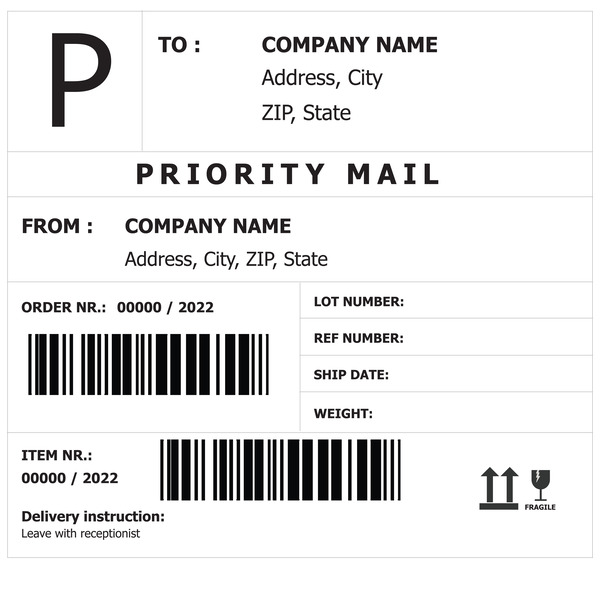
Creating shipping labels is one of the most critical aspects of e-commerce logistics. They are vital for customer trust and satisfaction, as well as for your store's success. From packing and supply chains to delivery and inventory management systems, shipping labels help streamline the process and ensure accuracy. If you're just starting out in e-commerce, this guide will help you understand how shipping labels work and how to create them for your business.
A shipping label is a sticker that attaches to your delivery package and contains all the information your shipping carrier needs to know. Unlike mailing labels, which only contain the recipient's information, a shipping label contains details about both the origin and the destination. It contains a scannable barcode with an order tracking number, enabling carriers to provide real-time delivery updates to businesses and customers. Each shipment requires a label with a unique barcode and information specific to different types of orders, such as perishable food, to ensure the carrier arranges for appropriate shipping conditions.
Shipping labels play an essential role in order fulfillment accuracy for e-commerce businesses. Below is a detailed overview of how they work.
The first step is creating the label. You can either purchase labels at a post office or arrange for them online through your preferred shipping carrier.
Shipping labels contain scannable barcodes. A barcode allows your shipping carrier to notify you and your customer about the order status. You can track the package's real-time location through a scannable barcode.
Shipping labels contain all essential information about the package, including the product type and the recipient's address. This information helps your logistics providers and shipping carriers identify, categorize, and route packages according to their destination, making the process faster.
If you ship orders internationally, shipping labels can help you with customs processing. These labels serve as a communication tool, providing the necessary information for customs officials to handle and clear the package.
Shipping labels contain specific information, including scannable barcodes and the recipient's address. This allows your shipping carrier to verify the address at the time of delivery. With a barcode, you can check if the parcel has reached your customer and confirm the delivery.
Shipping labels are crucial for error handling because they contain accurate information for tracking, sorting, and delivery of packages. This information helps minimize errors such as lost parcels and misrouted shipments. These labels also help identify perishable and fragile items and reduce damage.
Shipping labels can be seamlessly integrated with various shipping tools and platforms, which allows businesses to streamline their shipping operations. This is also why shipping carriers offer online tools for creating shipping labels.
Creating your own shipping label saves you time and money and allows the carrier to pick up packages directly from your facility. Here's how to create a shipping label for your e-commerce business.
Each shipping carrier has specific requirements when it comes to shipping labels, so you cannot create your own template or fill out a label by hand. You must choose a shipping carrier to create your labels.
Gather all required information, including the name and the address of the sender, the name and the address of the recipient, a barcode, a routing code, a postal barcode, a tracking number, and the chosen delivery service. Most of the information is generated automatically by the shipping carrier. You will only need to provide the names and the addresses of the sender and the receiver, as well as the delivery service method (e.g., express, standard, etc.).
Shipping carriers make creating shipping labels simple and easy. Go to your preferred shipping carrier's website and use their online tool to create a printable shipping label.
The tool on the shipping carrier's website is typically a template. Fill out the template with the shipping details, including the sender's and the receiver's names and addresses. The rest of the fields will be automatically filled by the carrier's tool.
Most carriers offer various shipping speeds, such as standard and express. Choose the option that best suits your needs within the carrier's online tool. This selection determines the delivery timeframe and the cost of your shipment.
After generating the label, you will have the option to download it. Once downloaded, ensure a printer is connected to your device. Print the shipping label on standard paper.
After printing, securely attach the shipping label to the package. Make sure the entire label is visible and flat against the surface. This allows for accurate scanning and delivery.
Once you have attached the label, the package is ready for shipment. Schedule a pickup from the shipping carrier or drop it off at one of their locations. From then on, your shipping carrier will be responsible for delivering your package to your customer.
Your shipping carrier will transmit the real-time location of the shipment to you. You can use the tracking number to track the shipment and to confirm the delivery status after the customer has received it.
Here's an example of a shipping label.

Shipping label consists of the following components:
New to creating shipping labels? Below are the best practices to keep in mind when creating a shipping label.
Make sure the information you enter in the shipping label template is accurate, especially the sender's and the receiver's names, addresses, and service type. The rest of the information will be filled out automatically by your shipping provider.
Make sure you use high-quality paper, since a shipping label provides critical information and shouldn’t be damaged. Glossy paper is a good choice because it's more resistant to wear.
Always make sure to place the shipping label properly on the package. If it's printed on a stick-on paper, make sure it adheres well. If you are using non-stick paper, use high-quality glue.
Make sure you protect the shipping label after it has been placed on the package. If it's not placed correctly and protected, it can become damaged or detached during shipping. A good practice is to tape over the label using transparent tape so it stays in place and protected.
A shipping label is key to successful logistics and shipping. It's the only way to ensure proper order tracking and delivery.
A shipping label includes the receiver's name and address, as well as the type of shipping service, ensuring that the parcel is delivered to the correct location at the right time.
A scannable barcode and an order tracking number on the shipping label facilitate efficient tracking, allowing both the business and the customer to track the order's location in real time.
A shipping label contains a routing number, which streamlines sorting and routing for the shipping carrier, enabling timely delivery and accurate order tracking.
One of the key benefits of shipping labels is that they support international shipping. If your recipient lives in a different country, a routing number on the shipping label ensures successful and efficient delivery.
A tracking number on the shipping label allows the customer to track the package's location in real-time. This ensures that your shipping services are transparent, elevating customer experience.
From the sender's details and the scannable barcode to routing and tracking numbers, each component of a shipping label plays a crucial role in a comprehensive logistics process. This information facilitates effective deliveries and reduces operational errors.
A shipping label also fulfills the carrier's requirements. As a result, your order is less likely to get lost in transit or be delivered to the wrong address.
A shipping label is one of the most important parts of a logistics process. It may seem like just a piece of paper, but it's a key part of what makes shipping efficient and error-free. For new and large businesses, tracking shipments and printing labels for each order can be a time-consuming and inefficient process. We can help you streamline the process and avoid costly mistakes that impair your operations. Encore Fulfillment offers flawless shipping label creation services. We will create shipping labels and ensure their proper placement on the packages, regardless of the number of orders you ship in a day. Visit our website today for an instant order fulfillment quote.
If your package is returned due to an issue with the label, you will need to create a new label and update the information before shipping. Make sure the label is securely attached and protected to prevent damage or loss.
Creating a shipping label is very low cost. You'll only be paying for printing paper and ink if you are printing at your facility.
Yes, shipping labels for international shipments are different from those used for domestic shipping. Shipping labels for international deliveries include specific information required for customs clearance. They may also have different routing numbers.
If your shipping label is damaged, there is a risk that your parcel may not be delivered. It may become lost in transit or be delivered back to the sender.
Yes, if you handle the shipment of your goods. However, if you outsource your shipping to a 3PL service provider, you don't have to worry about creating or printing shipping labels.
You cannot reuse a shipping label. Once the shipping label is used, it's essentially "canceled" in the system. Reusing it means you are using incorrect shipping information, and your parcel can be returned, lost, or delivered to the wrong address.

As the co-founder of Encore Fulfillment, I bring more than 14 years of experience across business strategy, technology, sales, marketing, and systems integration. My journey has been focused on building a fulfillment operation that not only meets but exceeds client expectations, through precise inventory management, streamlined operations, and a relentless focus on customer satisfaction.
From the ground up, I’ve played a key role in shaping our fulfillment division, implementing scalable processes and forward-thinking solutions that drive efficiency and deliver consistent, high-quality service. My background in pastoral ministry and theology has deeply influenced my leadership style, enhancing my ability to communicate clearly, guide teams with purpose, and build meaningful, trust-based relationships with clients and partners. At Encore Fulfillment, we don’t believe in one-size-fits-all. I’m passionate about crafting personalized logistics strategies that evolve with our customers’ needs, helping them grow confidently while we handle the complexities of order fulfillment. Whether supporting e-commerce brands or established enterprises, my goal is to ensure every partnership is rooted in integrity, transparency, and a shared commitment to success.